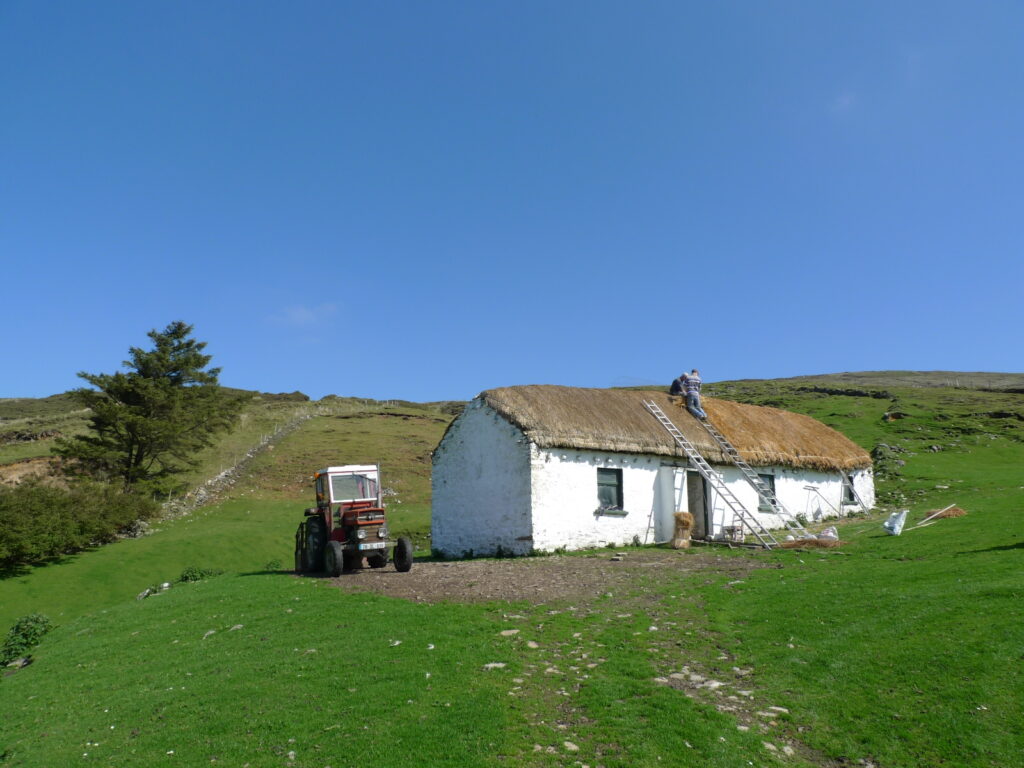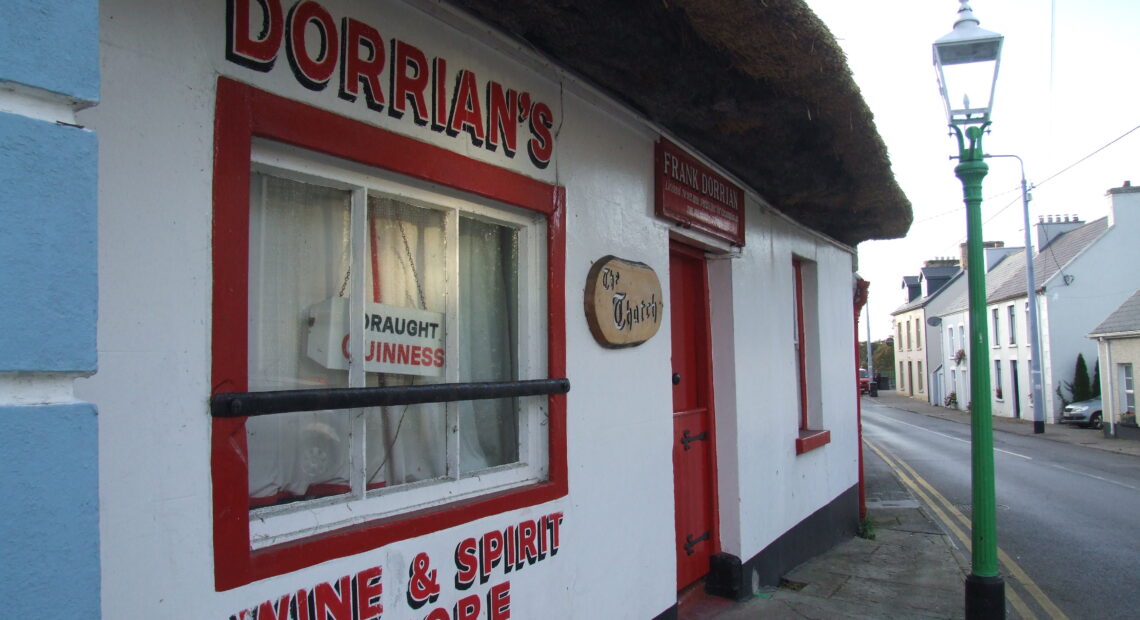Picture above: Dorrian’s Thatched Pub, Bishop Street, Ballyshannon
Donegal County Council’s award-winning Thatch Repair Grant Scheme has opened for applications.
Now in its third year, the scheme assists the owners and occupiers of thatched dwellings and businesses with their maintenance and repair. The grant scheme provides advice to owners on the conservation of thatched roofs, allocates funding for small-scale thatch repairs and helps homeowners carry out necessary repairs under conservation supervision. The scheme is open for applications until 12 noon on Monday, April 12 and is funded by Donegal County Council and The Heritage Council.
“Since its introduction in 2019, the Thatch Repair Grant Scheme has supported 38 thatch repair projects in the county” said Joseph Gallagher, County Donegal Heritage Officer. “The scheme provides an opportunity to conserve our remaining historic thatch, maintain an iconic aspect of our built heritage, provides employment for thatch material growers and local thatchers, and supports our tourism industry. We continue to learn more about thatch in the county as a result of the scheme too. We got to know some of the owners and custodians of our vernacular buildings who really are unheralded champions of our built heritage. We heard about the lack of availability of home-grown thatching materials but we’re also encouraged by the number of people who grow materials to thatch their own buildings. Were very fortunate to have a small number of highly skilled thatchers in the county and some people who practice their thatching skills on a part-time basis.”
“The future of historic thatch in County Donegal is at a critical point now. Training and employment opportunities exist in the conservation of traditional buildings but it’s surprising that over a decade after the publication of the All-Ireland Traditional Building Craft Skills report by the National Heritage Training Group that highlighted the dearth in availability of traditional building skills that little has been done to address the traditional building skills shortage.
Opportunities also exist for local farmers to grow thatch materials to support the local industry. We find that the availability of appropriate thatch materials is a serious impediment to the survival of our historic thatch. We also heard from homeowners about the lack of appropriate and affordable insurance for thatch structures.
County Donegal is home to one of the largest surviving concentrations of thatch structures in Ireland but if the insurance issue is not addressed, then the decline in the number of thatched structures seen in recent years will continue. The lack of insurance companies in the Republic of Ireland willing to provide quotes for historic thatch and the inability to get affordable insurance in some instances means that new generations of possible owners cannot live under thatch because insurance is required in order to take out a mortgage. Insurance companies in Northern Ireland, Britain and many other European countries seem better informed about historic thatch structures and can provide appropriate and more affordable insurance cover. It’s not clear why the situation in the Republic of Ireland is more prohibitive.”
“Donegal County Council considers that the conservation of our traditional buildings constitutes appropriate, sustainable and responsible development,” said Collette Beattie, Conservation Officer, Donegal County Council. “At present, there are over 20 thatched buildings on the Record of Protected Structures for County Donegal and many more are eligible for inclusion.
The Thatch Repair Grant Scheme addresses several Donegal County Council plans and strategies including the County Donegal Heritage Plan to “Encourage the conservation of thatch and thatching skills and materials in County Donegal as a distinctive aspect of the county’s heritage” as well as several policies in the Donegal County Development Plan to protect and conserve our traditional buildings. Types of small-scale thatch repairs that might be eligible to Donegal County Council’s Thatch Repair Grants Scheme include repairs to the eaves, the ridge, flashings around the chimney, holes, furrows, fixings, ropes, wire netting, the gable and the roof timbers or carpentry.”
Donegal County Council’s Thatch Repair Grant Scheme won the Chambers Ireland Excellence in Local Government Award in the ‘Heritage & Built Environment’ category last November. The award recognises the best local authority initiatives to promote public interest in, and knowledge, appreciation and protection of local heritage.
A statement made by Donegal County Council, said that
“They (thatched buildings) lend character to our cultural landscapes; they are indicative of our sense of place, our traditional skills and our resourcefulness; they can be sensitively adapted to meet modern family demands; they invoke our diaspora and support our tourism industry. Despite their importance and potential, the loss of our thatched buildings, especially in recent years, has been considerable. Traditionally rope thatching was the dominant thatching method in County Donegal although scollop thatching could be found in parts of east Donegal. Historic thatch materials varied considerably depending on the local vegetation cover and farming practices. Thatching materials used included wheat straw, oat straw, rye straw, flax, marram grass, water reed and even rushes.
While the Donegal County Council’s Thatch Repair Grants Scheme focuses on small-scale repairs and is likely to be highly competitive, there are other grant schemes that allow for the thatching and re-thatching of roofs. These include the Grant for the Renewal or Repair of Thatch Roofs of Houses administered by the Department of Housing, Local Government & Heritage; the Built Heritage Investment Scheme for Protected Structures by the Department of Housing, Local Government & Heritage and even the Irish Georgian Society Conservation Grants.
Assistance for the repair of thatched outbuildings is also available under the GLAS Traditional Farm Buildings Grant Scheme administered by The Heritage Council. Advice on all of these grants schemes is available from the County Donegal Heritage Office and the Conservation Office of Donegal County Council and on-line at www.donegalcoco.ie/heritage
Or by contacting Joseph Gallagher, Heritage Officer or Collette Beattie, Conservation Officer at (074) 915 3900 or by e-mail at [email protected] The Thatch Repair Grants Scheme is funded by Donegal County Council and The Heritage Council as part of the implementation of the County Donegal Heritage Plan.
Photo 1: Rope-Thatched Cottage, Straboy, Glencolmcille
Rope thatching a cottage in Straboy, Glencolmcille / Gleann Cholm Cille with support from the Thatch Repair Grant Scheme. West and north Donegal is one of the few areas where rope thatching is still practiced in Ireland.

Photo 2: Rope-Thatched Cottage, Ballykenny, Inishowen
Rope-thatched cottage in Ballykeeny along the Wild Atlantic Way in Inishowen was one of the properties that benefited under the Thatch Repair Grant Scheme in 2019. The scheme allows for small-scale thatch repairs as evidenced by the ‘patch’ repairs shown.
Photo 3: Rope-Thatched Extended Farmstead, Drimgorman
The Thatch Repair Grant Scheme allows for essential repairs to thatched roofs in order to allow people to continue to live under thatch such as this example of an extended farmstead from Drimgorman in south Donegal.
Photo 4: Scollop-Thatched Cottage, Ballindrait
This scollop-thatched, direct-entry cottage in Ballindrait supported under the Thatch Repair Grant Scheme displays clear evidence of the existence of the half-loft by the two small windows in the gable on either side of the hearth. The raised ‘barges’ on the gable provide protection for the thatch from winds.
Photo 5: Dorrian’s Thatched Pub, Bishop Street, Ballyshannon
Businesses are accommodated under thatch too and Dorrian’s thatched pub on Bishop Street in Ballyshannon is popular with residents and tourists alike. It was supported under the Thatch Repair Grant Scheme in 2020 for repairs to its scollop thatch.
Photo 6: Stooks of Rye Straw, Drumbarnett, near Manorcunningham
The Thatch Repair Grant Scheme has created an increased demand for thatch materials thus supporting farmers and growers of thatch materials in the county. The stooks of rye straw shown here in Drumbarnett near Manorcunningham in east Donegal are grown to support the thatch industry in the county.
Photo 7: Historic Thatch, Teelin
Seamus Ó hEochaidh thatching the roof of a cottage in Rinnakill, Teelin in the late 1930s. The intricate network of ropes used to secure the thatch were tied to projecting stones (bacán) at the eaves and on the gables (Image courtesy of Donegal County Archives, Donegal County Council).
Photo 8: Mannie’s Thatched Pub, Convoy
Examples of scollop thatching can be found in east Donegal. The rethatching of Mannie’s pub in Convoy demonstrates the use of scollops used to hold the thatch in place. Also shown are some of the layers of underthatch that provide insulation and a good foundation for the final layer of thatch.
Photo 9: Thatch Detail around Chimney near Clonmany
This chimney detail near Clonmany demonstrates the care that was taken to direct water away from vulnerable points of entry into the vernacular cottage. The thatch is firmly secured to the gable and chimney with ropes. Part of the chimney to the projecting stone course is thatched to throw the water off the roof and the boundary between the thatch and the gable is rounded making it more aerodynamic and encouraging water to drop onto the adjoining corrugated iron roof below.
Source: Donegal County Council













